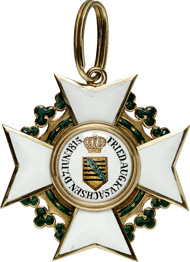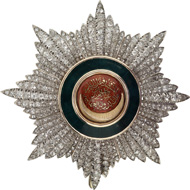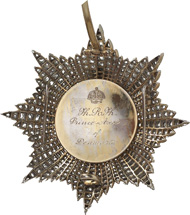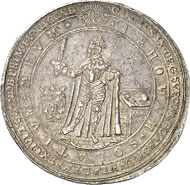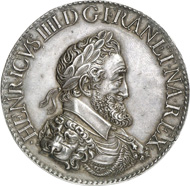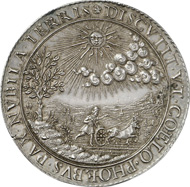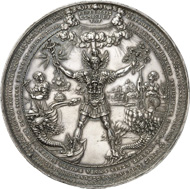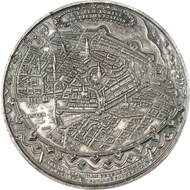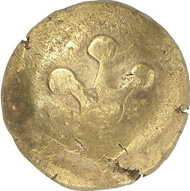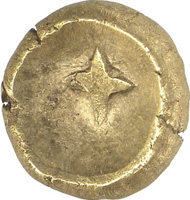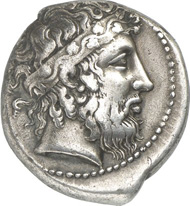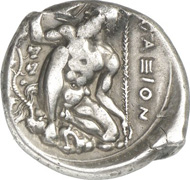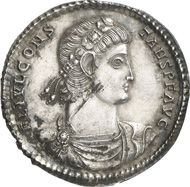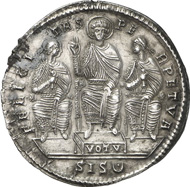18-11-2013 – 20-11-2013
Auctions 240-243
Coins, Orders, Decorations and Medals: the Winter Auction of Künker
Shortly before the Advent season, auction house Künker edges additional auction days in. From 19th to 21st November 2013, the sale will take place featuring among others the most important-ever sale of orders and decorations of Künker comprising 1,119 lots and coming with a total estimate of 754,000 euros. The whole sale offers 3,825 lots at an impressive total of 3 million euros. Collectors will spot world coins and medals from antiquity to today.
Auction 240: Orders and Decorations
Collectors of orders and decorations in particular are requested to schedule no other dates for 19th November 2013 because Künker offers its most important range ever in auction sale 240.
As always, Michael Autengruber has written the accompanying catalog in which not only the illustrations are colorful.
107: Prussia. Pour le mérite. Order cross. From the property of William Balck. KWK2 196var. II-III / II. Estimate: 10,000 euros.
Many human fates are brought alive, thanks to decorations awarded, like, for example, the fate of the Balck family, whose members served in the army by tradition. Konrad Friedrich August Henry William Balck had been born on 19th October 1859 in Osnabrück. The English sound in his name must be seen against the political backdrop of those days: back then, Osnabrück was part of the Kingdom of Hannover that, from its coming into being, had been ruled by George IV who likewise ruled the United Kingdom of Great Britain and Ireland. In 1866, Prussia annexed Hannover, and so William Balck launched his military career in the Prussian army. He ended as lieutenant-general and complete his career in 1918 as governor of the then Baltic island of Ösel, Moon and Dagö in the Baltic Sea. William Balck gained fame thanks to his “Tactics” in six volumes, which was translated into seven languages, including Japanese and Russian. Rare and extraordinary orders from his possession are on offer, like the Prussian pour le Mérite (34; II-III/II; estimate: 10,000 euros). Foreign rulers as well conferred decorations on the meritorious military officer, such as George I of Greece with the Royal Order of the Redeemer (65; I-II; estimate: 750 euros) and Carol I of Romania with the Order of the Crown of Romania (71; II/II-III; estimate: 150 euros).
His eldest and only son adhered to family tradition, too. Hermann Balck, born in Danzig in 1893, entered the military service immediately after having finished school. He served both in World War I and in World War II. His career was terminated by the surrender after he had risen to the rank of ‘General der Panzertruppe’ (Lieutenant-General of Armored Troops) and ‘Heeresgruppenbefehlshaber’ (Commander of Army Group) in World War II. His autobiography bearing the title “Ordnung im Chaos” lively and thoughtfully tells of the ethos of a family of officers as it can’t be encountered anymore. Amongst other items from his possession, his specimen of the Knight’s Cross of the Iron Cross with Oak Leaves, Swords and Diamonds will be offered for sale, which was awarded 27 times only (208; I-II; estimate: 150,000 euros).
1085: Ottoman Empire. Order of Osmanieh. 2nd class. Extremely fine. I-II. Estimate: 30,000 euros.
Naturally, a high number of others orders will be on offer, too, from the German Reich and the Federal Republic of Germany as well as from Austria, Belgium, Denmark, France (with a large collection), Greece, Great Britain, Italy, Malta, Monaco, Portugal, Romania, Russia, Spain and Sweden. Another 200 lots come from overseas countries. What price may the two specimens of the Russian Order of the White Eagle obtain? They carry a pre-sale price tag of 30,000 and 40,000 euros. In the Künker auction sale conducted in June 2013, a similar piece yielded 160,000 euros.
Auction 241: World Coins
Roughly 1,600 lots containing coins from Germany as well as coins from all over the world in gold and silver will be sold in auction 241. The international offer covers the entire span from Andorra to Venezuela.
2281: Sweden. Charles IX, (1560-) 1604-1611. 3 riksdaler 1610, Stockholm, on the founding of the city of Gothenburg. Ahlström 73. Extremely fine. Very fine. Estimate: 30,000 euros.
The collectors of Swedish coins are particularly likely to find exciting material there, like a multiple thaler worth 3 riksdaler, minted under Charles IX in Stockholm, on the founding of Gothenburg (2281; VF; estimate: 30,000 euros). This collection is remarkable due to its outstanding quality. Nearly all pieces are referred to as being “Rare in this condition. Splendid specimen.”
2186: Germany. Hamburg. 1/2 bankportugalöser of 5 ducats 1687. From SBV 34 (1994), 1291. Very rare. Very fine. Estimate: 30,000 euros.
In the German section a number of coins from the city of Hamburg shines out. The spectrum ranges from 1/4 portugalöser of 2 1/2 ducats, minted between 1578 and 1582 (2183; VF-EF; estimate: 15,000 euros) to 1/2 bankportugalöser of 5 ducats from 1687 struck from the thaler dies (2186; VF; estimate: 30,000 euros), and in addition many double ducats, ducats, gold and silver strikes, thaler 1/2 thaler and mark pieces. Anyone collecting coins from Hamburg can place a bidding as low as 100 euros.
Auction 242: Historical Medals
The fan of historical events ought to pay catalog 242 a closer look. There, he will find the illustrations of European history, marvelous medals issued as early as the Renaissance, remembering battles, treaties and important characters.
When compared with other coins of similar quality and rarity, the prices of these items are still modest. Let us take a silver medal for example, issued under French King Henry IV. That ruler had an exceptional attitude towards his subjects, as can be inferred from his famous quote: “If God keeps me, I will make sure that no peasant in my realm will lack the means to have a chicken in the pot on Sunday!” (“Si Dieu me prête vie, je ferai qu’il n’y aura point de laboureur en mon royaume qui n’ait les moyens d’avoir le dimanche une poule dans son pot!”).
3010: France. Henry IV, 1589-1610. Silver medal n. y., unsigned, on The Happy State of France. Jones 200. Extremely fine. Estimate: 1,000 euros.
This attitude is reflected in a motif, a very unusual one for that period, on a medal: a peasant ploughs his field under a caringly radiant sun. More than any coin, this medal is a testimony to what the monarch wanted to present his people with. And the extremely fine piece is estimated at 1,000 euros only. Probably much higher will be the price one has to pay for the Bavarian gold medal of 18 ducats of the first king of the country, Maximilian I Joseph. It was produced in 1824, on his 25th throne anniversary (3390; about FDC; estimate: 15,000 euros). 10 years before that, the Prussian medalist L. Pöninger had created a medal on the Treaty of Paris. The specimen offered by Künker consists of gold and thus is a hitherto unpublished unique specimen (3436; VF-EF; estimate: 15,000 euros).
3527: Germany / Hamburg. Silver medallion 1636, by S. Dadler. Very rare. Extremely fine to FDC. Estimate: 20,000 euros.
The auction sale’s unrivalled highlight is a large medallion with a diameter of almost 8 centimeter by Sebastian Dadler with a bird’s eye view city map of Hamburg on its reverse. The obverse shows a Hamburg version of the Colossus of Rhodes as part entrance lifting both an olive branch as a symbol of peace and the staff of Mercury as a symbol of trade. Because of that, the piece takes its place amongst the Hope for Peace medals (3527; EF-FDC; estimate: 20,000 euros).
Auction 243: Coins from the Ancient World
On 21st November 2013, the winter auction of Künker’s will be concluded by almost 1,400 lots of ancient coins. It starts with a big special collection of Celtic coins comprising 500 lots. The range of offers covers everything from English Iron Age to the Danube region of Dacia. The carefully selected pieces stand out because of the special eye the collector had for exceptional depictions. This extraordinarily representative collection has no peer in terms of its multitude of motifs. With Celtic coins still being rather inexpensive – when compared with Greek and Roman coinages – the collector can enter the bidding with 60 euros already.
4402: Celts. Vindelici (southern Germany). Rainbow cup, 175-100. Very rare. Very fine. Estimate: 4,000 euros.
The great selection of so-called rainbow cups is especially likely to arouse attention. Apart from the ordinary types (plain, bird’s head and serpent type), the three dot flower (4402; VF; estimate: 4,000 euros) and the calyx-like volute (4423; VF; estimate: 4,000 euros) are likewise available.
4574: Greeks. Naxos. Tetradrachm, 430-420. Cahn 100. From auction sale Hess 247 (1978), 52. Very rare. Good very fine. Estimate: 25,000 euros.
Approximately 170 lots with Greek coins are on offer, including an extremely fine tetradrachm from Classical Naxos, minted 430/20 (4574; VF+; estimate: 25,000 euros) and the catalog’s cover piece, a tetradrachm from the city of Barke with the head of Zeus Ammon in frontal view on its reverse (4663; ss; estimate: 20,000 euros).
The Roman coins constitute the major part of the catalog. A number of them once belonged to the collection of Dr med Gerhard Himmel, Graz. The physician had been interested in coins from early on. His widow, who actively participated in her husband’s collecting, now wants to see the coins reflowing into the numismatic circulation, delighting other collectors as well. And they surely will, for the collection includes many rare emperors and empresses – like Pacatianus, Cornelia Supera, Regalianus, Dryantilla and many more. The highlights of the Roman coins are an almost extremely fine aureus of Didius Iulianus (4934; about EF; estimate: 12,500 euros), an aureus of Maximianus from 293/5, minted in Antioch (5194; EF-FDC; estimate: 10,000 euros), …
5250: Romans. Constans, 337-350. Medallion of 4 siliquae, 337/340, Siscia. RIC 41. Extremely rare. Extremely fine. Estimate: 40,000 euros.
… and, most of all, a large silver medallion of 4 siliquae of Constans, minted in Siscia between 337 and 340 (5250; EF; estimate: 40,000 euros).
The catalogs can be ordered at Künker, Gutenbergstrasse 23, D-49 076 Osnabrück; phone: +49 (0)541 / 96 20 20; fax: 0541 / 96 20 222; or via email.
All coins can be viewed online four weeks prior to the auction sale.




